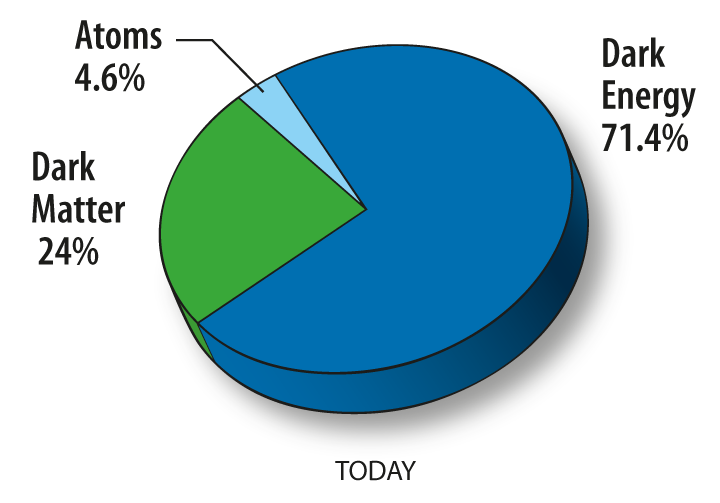By: Paige Copenhaver, Athens Science Café
Most people have heard of dark matter and dark energy in the news or in the media. For example, in Star Trek: The Next Generation, the Enterprise encounters a dark matter cloud. In Futurama, dark matter is used to fuel starships. Though many people are familiar with the terms, few people understand much about dark matter or dark energy. You may be surprised to know that scientists know very little about these concepts, too! What we are sure of, however, is the amount of each component of the universe: “regular†matter, dark matter, and dark energy (1). To give you a visual of how little we actually know about the universe, check out this pie chart. The only section we are very familiar with is the small chunk labeled “Atoms.†As you can see, dark matter and dark energy make up about 95% of the universe!

(NASA)
What is dark matter?
The short answer is we're not really sure. We know more about what dark matter isn't than what it is. It is theorized that dark matter is made of exotic particles called Weakly Interacting Massive Particles (WIMPs). “Weakly Interacting†comes from the observation that dark matter interacts with regular matter via weak forces and the gravitational force, which is very weak itself (2). We know these particles are massive because they affect regular matter gravitationally, and only objects with mass can have a gravitational effect on the objects around them. The “dark†in dark matter simply refers to the fact that this type of matter emits no light. Whether we humans can see it or not, all normal matter emits light of some wavelength. Yes, this means you are emitting light right now! Humans emit light in the near infrared range of the electromagnetic spectrum (3). This is called blackbody radiation.
We know dark matter is different from regular matter because it A) does not emit any light at all, and B) is not in the form of clouds. Virtually all regular matter in the universe is comprised of gas and dust, and we can measure the frequency of light that these dusty clouds absorb. With dark matter, however, we cannot detect any light absorption passing through, which tells us dark matter does not form clouds like most regular matter does.
Scientists can measure the approximate amount of mass in the universe through density calculations. For a detailed explanation of how they do this, check this out. The generally accepted percentage of total mass in the universe is about 28%. As we discussed earlier, the total amount of mass from visible matter (matter that emits light of any wavelength) only makes up ~4.6% of the total 28%. Thus, dark matter makes up the rest of the mass of the universe.
What is dark energy?
Albert Einstein was the first to theorize that empty space is not truly empty; it has an immense amount of energy (4). Since matter, both regular and dark, makes up about 28% of the universe, dark energy is what fills the rest of the empty space. It is a generally accepted fact that the universe is expanding, and dark energy is thought to propel the acceleration of the expansion. Without dark energy present to overcome the gravitational force, everything in the universe would be moving closer together due to the pull of gravity, and the universe would eventually collapse. As the diagram below shows, this sets the age of the universe much younger than we know it to be (see “recollapsing universeâ€). The only way the universe's age is correct is by taking dark energy into account.

Concluding Thoughts:
I hope from reading this you will at least take this away: regular matter is really not “regular†at all, as it makes up such an insignificant portion of the universe. Because we know very little about dark matter, an immense amount of research is being conducted to better understand its properties. Though we know very little about dark matter, we know even less about dark energy. Hopefully someday we will be able to fully comprehend these unusual concepts that are so important and prominent in our expanding universe.
References:
(1) http://map.gsfc.nasa.gov/universe/uni_matter.html; (2) http://www.cfhtlens.org/public/what-dark-matter ; (3) Hardy, James D. “The Radiation of Heat from the Human Body.” The Journal of Clinical Investigation 13.4 (1934): 616. National Center for Biotechnology Information. Web. <http://www.ncbi.nlm.nih.gov>. ; (4) http://hubblesite.org/hubble_discoveries/dark_energy/de-what_is_dark_energy.php; Density calculation explanation: http://www.astro.ucla.edu/~wright/density.html; Cohen, David X., and Groening, Matt. Futurama. Television.; Menosky, Joe, and Ronald D. Moore. Star Trek: The Next Generation. 3 June 1991. Television.
Photo Credits:
NASA – http://map.gsfc.nasa.gov/universe/uni_matter.html; Science Blogs – http://scienceblogs.com/startswithabang/2009/07/15/the-last-100-years-1998-and-th/
 Paige Copenhaver is an undergraduate studying Physics and Astronomy at the University of Georgia. When she is not studying solar-type stars, she can be found playing ukulele or reading Lord of the Rings. You can email her at pac25136@uga.edu or follow her on twitter: @p_copenhaver.
Paige Copenhaver is an undergraduate studying Physics and Astronomy at the University of Georgia. When she is not studying solar-type stars, she can be found playing ukulele or reading Lord of the Rings. You can email her at pac25136@uga.edu or follow her on twitter: @p_copenhaver.
About the Author
- athenssciencecafehttps://athensscienceobserver.com/author/athenssciencecafe/April 17, 2020
- athenssciencecafehttps://athensscienceobserver.com/author/athenssciencecafe/April 12, 2020
- athenssciencecafehttps://athensscienceobserver.com/author/athenssciencecafe/April 3, 2020
- athenssciencecafehttps://athensscienceobserver.com/author/athenssciencecafe/March 30, 2020







